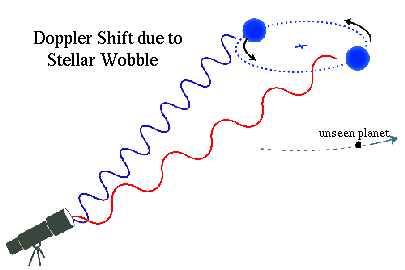Doppler Shift
The Unseen Planet
The Doppler Technique for finding Sub-Stellar Objects

What happens when a train or ambulance passes us? Moving towards us,
the pitch is high (blue-shifted), after it passes the pitch is low (red-shifted).
The speed of sound is 740 miles/hour ---fast, but not so fast that our ears can't
detect the shift. We do not normally see a
Doppler shift in light, however. Light travels 300,000 km/second = 675
million miles/hour.
When one object is a dark, yet massive planet, then we
see only the spectrum of the star. It is seen to wobble or
shift, red, blue, red, blue, indefinitely, with the period of the star-planet
orbit.
The more massive the planet the bigger the wobble.
The closer the planet, the shorter the period.
If the planet were Pluto-Sun distance, we'd have to
wait 250 years for a full velocity shift!
Typical velocity shifts are tens of meters/second --one part
in 300 million.
The short period of this system, just a few days, makes it easy to find.
